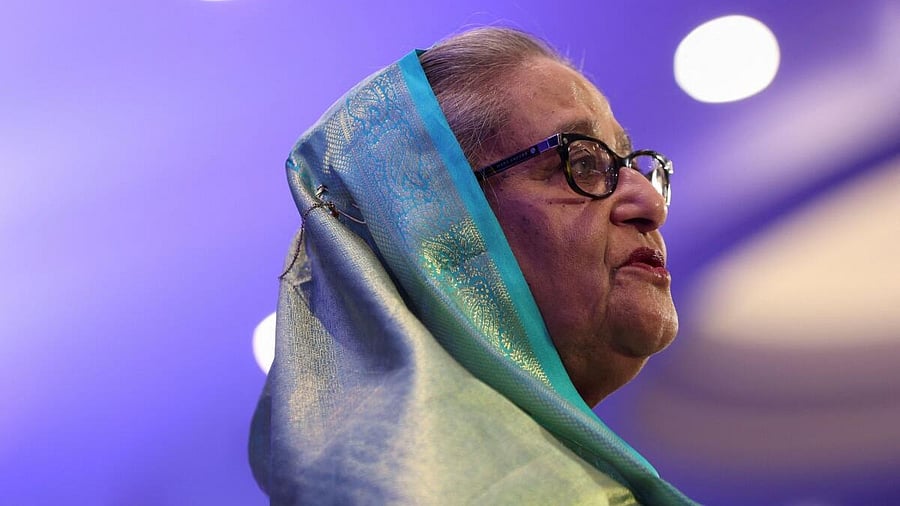
File photo of former Prime Minister of Bangladesh Sheikh Hasina.
Credit: Reuters Photo
New Delhi/Dhaka: For nearly two decades, Sheikh Hasina’s name moved with the pulse of Bangladesh, sometimes steady, sometimes storm-tossed.
To her supporters, she is the architect of a modern, developing Bangladesh; to her critics, she was an autocrat whose appetite for power blinded her to the cries of the streets.
Few, however, could have imagined that the very tribunal the 77-year-old deposed prime minister once created to try hardened war collaborators would one day place her in the dock.
On Monday, when the International Crimes Tribunal (ICT) pronounced the death sentence against Hasina in absentia, it marked the most dramatic turn yet in the story of the world's longest-serving female head of government.
Hasina was born on September 28, 1947, in Tungipara in the then East Pakistan, into a family that would come to define Bangladesh’s identity. Her father, Sheikh Mujibur Rahman, led Bangladesh to independence with India’s help in 1971 and became its founding father.
She studied at the University of Dhaka, earning a master’s degree in Bengali literature, and became deeply engaged in student politics.
In 1968, Hasina married nuclear scientist M A Wazed Miah, whose low-profile, scholarly life stood in contrast to the turbulence of Bangladeshi politics.
Wazed remained a steady presence in Hasina's life until he died in 2009 at the age of 67. They have a son, Sajeeb Wazed Joy and a daughter, Saima Wazed Putul.
Hasina's political destiny hardened after the August 1975 military coup, in which her father, mother, three brothers, and several other family members were assassinated. She and her younger sister Rehana survived only because they were abroad.
India, under then Prime Minister Indira Gandhi, granted her asylum. After six years, in May 1981, Hasina returned to Bangladesh, where she was elected in absentia as the general secretary of the Awami League.
When Hasina returned in 1981 to lead the Awami League, she found her rival already waiting: Khaleda Zia, widow of slain president Ziaur Rahman.
The ‘Battling Begums’, as they came to be known, fought electoral and ideological wars that defined Bangladesh’s politics for more than three decades.
Hasina first became prime minister in 1996, defeating Zia in a fiercely contested election. She lost power in 2001 but returned with a landslide in 2008, beginning, what her critics say, a long stretch of dominance.
Under her leadership, the Awami League swept the 2008 general election; the 2014 election, which was boycotted by Zia’s Bangladesh Nationalist Party (BNP); and the 2018 election, giving Hasina one of the world’s longest tenures for a female leader.
During her premiership, Bangladesh saw rapid economic growth, major infrastructure achievements like the Padma Bridge, and advances in poverty reduction.
The country also became a global garment powerhouse under her watch.
But the accolades came alongside accusations of clampdowns on dissent, curbs on the media, arrests of opposition leaders and the expansion of state security powers.
In 2024, student-led demonstrations, which initially erupted in protest over quotas in government jobs for children of independence war veterans, later exploded into a nationwide uprising against Hasina’s regime.
The crackdown that followed unleashed spirals of violence, ultimately ousting Hasina from power and forcing her to flee to India.
Following Hasina’s ouster, the interim government led by Muhammad Yunus reconstituted the ICT, once her instrument for prosecuting war criminals, to bring charges of crimes against humanity related to the 2024 crackdown against her.
A UN rights office report estimated that up to 1,400 people were killed during last year’s student protest between July 15 and August 15 during what came to be known as the July Uprising, as her government ordered a sweeping security crackdown.
On Monday, after months of proceedings she never attended, the tribunal handed down the unthinkable: Hasina, four-time prime minister and political heir of Bangladesh’s founding leader, was sentenced to death.
Now, in exile in India, Hasina, often dubbed the ‘Iron Lady’ of Bangladesh, watches from across the border as the nation she helped build, and often ruled with a firm hand, grapples with the legacy her rise and fall has left behind.